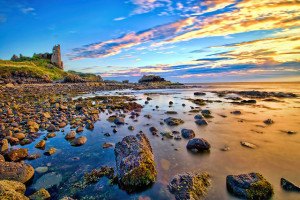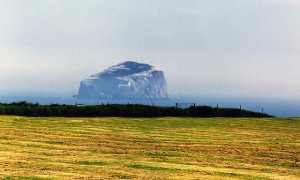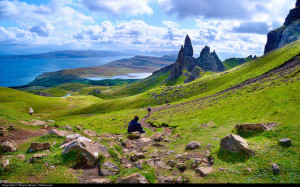Regardless of your feelings toward last year’s “nae” vote on breaking away from the UK, Scotland’s spirit of independence, natural beauty, and rich enduring cultural heritage make it a remarkable place to visit any time of year. (Yes, we know it gets a wee bit chilly and damp in the off season, but that just adds to its atmospheric charms.)
Baby boomers will have heard about many of these attractions most of their lives (Harry Potter sites and Edinburgh Festival Fringe excepted — but it’s always good to experience something new).
Here are my favorite reasons for booking a trip to this nation of 5.3 million people that has less land than South Carolina — but boasts an inordinate number of claims to fame:
- Edinburgh and Its Castle
One of Europe’s most architecturally stunning capitals, Edinburgh lies a mere 332 miles north of London and just south of the charmingly named Firth of Forth, an estuary that feeds into the North Sea. Looming dramatically over the city like a brooding medieval fortress is Edinburgh Castle, once home to Mary, Queen of Scots, and other Scottish royalty. It now houses Scotland’s crown jewels and other treasures and stands at the highest end of a succession of historic streets known collectively as the Royal Mile.
- Fun Festivals
Each August, Edinburgh is also home to the annual Edinburgh International Festival, which draws outstanding performers in drama and music from around the globe. At roughly the same time, the newer, more cutting-edge Edinburgh Festival Fringe has grown even larger than its progenitor — now calling itself the largest arts festival in the world — while the colorful Military Tattoo presents Scottish regiments decked out in tartan finery as they march and play their bagpipes and drums with Edinburgh Castle as a backdrop. For Olympics and sports fans, you can attend the Highland Games, complete with caber tossing, bagpiping, and dancing.
- The Highlands
North of Edinburgh are the Highlands, Scotland’s mountainous, sparsely populated region where ancient clans once held sway. The Highlands actually harbor fewer people today than they did three centuries ago — meaning you’ll find rugged, unspoiled scenery, hilltop castles perched over the moors, crystalline lochs (lakes), and seaside fishing villages. If feeling particularly energetic, climb some of the many local mountains (“Munros”) that top 3,000 feet, known as “Munro bagging.”
- Whisky
For a sample of local refreshment, you can follow the Malt Whisky Trail to seven distilleries — such as Glenlivet and Glenfiddich — that welcome the public. The word “whisky” is derived from the Gaelic for “water of life.” Savor some whisky in a local pub in a small village or a neigborhood in Inverness to get a sense of how the Scottish live today and hear old stories…The Battle of Bannockburn (of Braveheart fame) is still toasted to 800 years later.
- The Islands
Even more remote than the Highlands are Scotland’s nearly 800 islands (130 of which are inhabited) lying off its western and northern coasts. You can fly or take a ferry to the Inner and Outer Hebrides, the Orkneys, or the Shetlands, where you’ll find serenity, isolated beaches, a wealth of seabirds and other wildlife, and 6,000-year-old archaeological sites and burial mounds.
- Literary Tours
On a Scottish literary tour, you can visit Abbotsford, the castle-like home of the poet and novelist Sir Walter Scott in the scenic Scottish Borders area, as well as the Birthplace Museum of Scottish National Bard Robert Burns in the Alloway countryside. And I would be remiss not to mention that J.K. Rowling, author of the Harry Potter series, penned most of her books while living in Scotland. You can visit the bistro Spoon in Edinburgh where she spent hours penning the breakthrough Harry Potter and the Philosophers Stone. The books drop hints that Hogwarts, Harry’s fictional School of Wizardry, is located in Scotland, and the Glenfinnan Viaduct in the West Highlands is pictured in the Potter films when Harry rides the train to Hogwarts.
- Nessie
What visit to Scotland is complete without a stop at Loch Ness, situated south of Inverness in the Highlands and home to the world’s most famous mythological (we think) creature, the Loch Ness Monster? This is your chance to train your camera on the loch in hopes of finally capturing that elusive photo that proves, once and for all, that Nessie exists, offering you ample incentive to head off next to Northern California in search of Bigfoot and to the Himalayas in search of Yeti. Whether you get your Pulitzer Prize-winning photo or not, the cruise and sightseeing around the lake are breathtaking in their own right — even without a dinosaur experience.
- The Birthplace of Golf
Dedicated golfers can tour landmarks of the links such as Gleneagles, Carnoustie, Royal Troon, and of course, St. Andrews, a North Sea village where the sport was born some six centuries ago. St. Andrews’ famed Old Course requires a two-year advance tee time (you might want to contact a tour operator with some pull). But if you’re shut out of that, St. Andrews Links offers four other challenging courses, Europe’s largest golf complex.
Bonus: A Lot More
Did we neglect to mention kilts, bonnie lassies and laddies, thistle, heather, and Highland flings? And then there’s haggis — the national dish — which involves a yummy concoction of minced organ meats, oatmeal and seasonings boiled in the lining of a sheep’s stomach. It’s just the thing to fuel you up for playing 18 more holes, bagging a few more Munros, diving headlong into Loch Ness in search of Nessie — or even working up the nerve to wear a kilt.
An earlier version of this post appeared on StrideTravel.com, the premier online site for locating the best in organized travel around the world.















2 Responses to Top Eight Reasons to Tour Bonnie Scotland